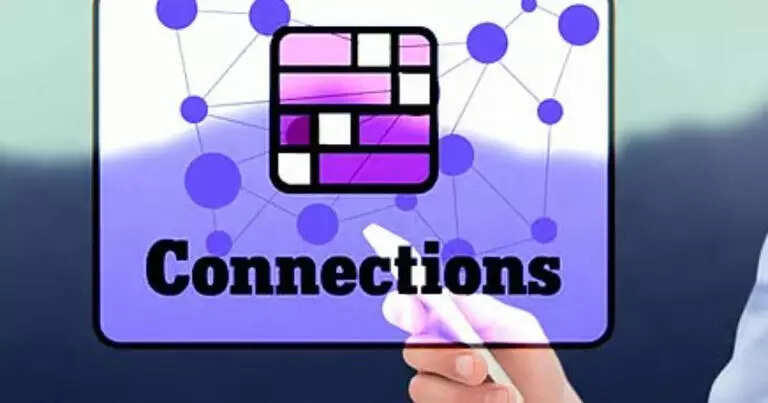
The New York Times’ “Connections” game has rapidly gained popularity among word puzzle enthusiasts since its launch. Unlike traditional crosswords or word searches, Connections requires you to identify four groups of four words that are connected in some clever or thematic way. The challenge lies in the subtlety of these connections—some are obvious, but others can be quite tricky.
Whether you’re new to the game or aiming to improve your solving speed and accuracy, understanding how to use and interpret connections hint can greatly enhance your strategy. This comprehensive guide explores how hints work, how to use them effectively, and how to develop your own intuition for uncovering hidden connections.
What is the NYT Connections Game?
The NYT Connections game is a daily word puzzle from The New York Times. Your goal is to organize a grid of 16 seemingly unrelated words into four groups of four that share a common thread. These categories can range from movie titles and book series to slang terms, historical events, or even types of pasta.
Each group is color-coded based on difficulty:
- Yellow (Easy): Usually the most straightforward connection.
- Green (Moderate): Slightly trickier but generally recognizable.
- Blue (Challenging): Often includes wordplay or less obvious groupings.
- Purple (Difficult): The hardest, usually requiring deep knowledge or clever associations.
Unlike crosswords, you don’t get clues for each word. That’s where connections hints come into play—either provided by The New York Times (subtly) or sought from external resources and puzzle communities.
What is a Connections Hint?
A “hint” in the context of the NYT Connections game refers to any clue, suggestion, or pattern that helps identify how a set of words are grouped together. While The New York Times doesn’t give formal hints in the game interface, there are several types of indirect clues you can use or recognize:
a. Pattern Recognition
Spotting patterns in words—like shared prefixes, suffixes, themes, or formats (e.g., all caps, hyphenated, pluralized).
b. Thematic Clues
Recognizing that a few words belong to a known theme, such as car brands, song titles, or internet slang.
c. Wordplay
Some hints involve homophones, double meanings, puns, or words that fit into a common expression.
d. External Hints
Many players turn to puzzle communities on Reddit, Discord, or gaming forums for daily nudges that don’t spoil the solution but help nudge players in the right direction.
Strategies for Identifying Connections
If you’re stuck, here are expert-level strategies and how “hints” come into play:
a. Look for Obvious Groupings
Start with the easiest. Try to find words that immediately scream “group” — for example:
- “Red, Blue, Yellow, Green” → Colors
- “Toyota, Ford, Tesla, Honda” → Car Brands
These form the yellow or green groups and can give you momentum.
b. Use the “Three-Word” Test
Pick three words that seem connected and search for a fourth that might match. This reduces the noise of 16 words and helps you zoom in.
c. Apply External Knowledge
If you recognize that two or three words are names of philosophers, characters from a TV show, or types of birds, use your background knowledge. These contextual hints often solve the blue and purple categories.
d. Process of Elimination
Once you’ve found a group, remove them from the board. The remaining words often make connections more visible.
Types of Connections to Look For
The hardest part of the game is understanding what types of connections hint the game creators use. Here are some common patterns:
a. Synonyms or Antonyms
Words that share a similar or opposite meaning.
Example:
Chilly, Cold, Frigid, Icy → Synonyms for cold
b. Category Members
Objects, places, or names belonging to a category.
Example:
Rome, Paris, Tokyo, Madrid → Capital cities
c. Homophones / Homonyms
Words that sound alike but mean different things or words that have multiple meanings.
Example:
Sole, Soul, Sell, Cell → Homophones
d. Puns and Wordplay
Connections involving idioms or plays on words.
Example:
Bat, Pitch, Diamond, Base → Baseball terms
e. Grammatical Forms
Words that are all adjectives, verbs, pluralized nouns, or compound nouns.
Example:
Running, Jumping, Swimming, Cycling → Gerunds
f. Hidden Themes
Some groupings are clever references to movies, songs, or pop culture.
Example:
Ross, Rachel, Monica, Chandler → Characters from “Friends”
How to Use Community Hints Without Spoiling the Fun
Many players turn to communities like Reddit’s r/NYTConnections for daily hints. These are typically organized into spoiler-free formats such as:
- “One group today includes types of metal”
- “There’s a group related to animals”
- “Think about common smartphone apps”
These allow you to get a gentle nudge without revealing the answer. Here’s how to use them effectively:
a. Read Hints Selectively
Only look at the first or second hint if you’re totally stuck. Don’t go through all of them unless you’re okay with spoilers.
b. Try to Guess Before Clicking Hints
This keeps your brain actively engaged. Treat the hint as your second-to-last resort—reserve full spoilers as a last option.
c. Avoid Daily Spoilers on Social Media
If you play late in the day, mute “Connections” or keywords on platforms like X (formerly Twitter), Reddit, or YouTube to avoid accidental reveals.
How to Create Your Own Connections Hints
If you enjoy making word puzzles or want to help others without giving away solutions, you can craft your own subtle connections hint. Here’s a template for different hint styles:
a. Category Hint
“Four of today’s words belong to the same category you’d find in a grocery store aisle.”
b. Riddle Hint
“They are hard on the outside but soft within, and you eat them for breakfast.” → Could point to types of cereal or fruit.
c. Wordplay Hint
“These words may leave you ‘buzzing’ with the right answer.” → Could point to insects or energy drinks.
By crafting these, you’ll improve your analytical skills—and possibly even become a Connections creator yourself!
Common Pitfalls to Avoid
Even seasoned players fall into traps. Here are some errors and how hints can help prevent them:
a. False Friends
Some words are intentionally placed to look like they belong together but don’t. For instance:
Example Trap:
Bass, Drum, Guitar, Scale
You might think “Musical Instruments,” but “Scale” is a red herring here.
b. Overthinking
The purple category can sometimes make you overanalyze. Not every word involves deep trivia—sometimes the answer is simple, and the complexity is misdirection.
c. Confirmation Bias
If you’re convinced a set belongs together, you may overlook better fits. Hints can reframe your thinking to consider other angles.
Tools and Resources to Use Alongside Hints
To solve puzzles more efficiently, try using the following resources in tandem with hints:
a. Online Thesauruses and Dictionaries
For checking word meanings, synonyms, and origins.
b. Pop Culture Wikis
TV Tropes, IMDb, or Fandom Wikis can help when categories are based on series, games, or historical events.
c. Reddit & Discord Communities
Great for non-spoiler hints and strategy discussion.
Final Thoughts: Why Connections Hints Make You Smarter
Using and understanding connections hints is more than just a shortcut. It’s a way to:
- Boost your pattern recognition
- Sharpen your logical deduction
- Expand your vocabulary and general knowledge
- Enjoy a shared puzzle-solving culture
Whether you play to compete, relax, or train your brain, each game—and each hint—is an opportunity to become a more perceptive thinker.
Conclusion:
The NYT connections hint game is deceptively simple but intellectually rich. At its core, it’s a challenge of pattern recognition, cultural awareness, and word mastery. Hints—whether subtle, crowd-sourced, or self-created—play a vital role in keeping the game accessible yet stimulating.
By understanding how hints work and integrating them into your daily routine, you can boost both your performance and enjoyment. The more puzzles you play, the more refined your intuition becomes. And with the right hint at the right time, that elusive purple group might just click into place.
So next time you’re stuck, remember: it’s not cheating—it’s connecting.





